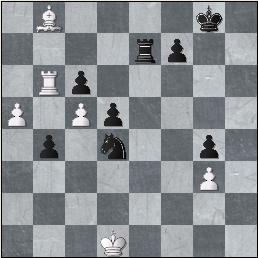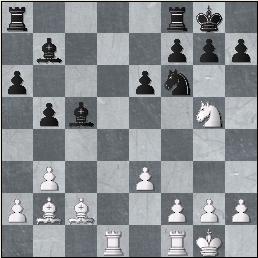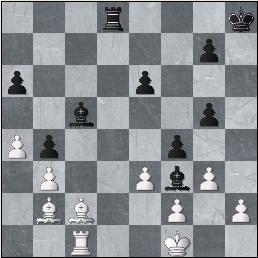21.02.2007
Game of the Round (3)
In the two previous rounds the choice of "Game of the round" has been practically obvious for me. As for the third round the only obvious thing is which game is definitely NOT a prize-winner... So I preferred to examine the most interesting moments of the games played in this round and some possibilities left behind the scene. I'd like to remark in passing that in the game Topalov – Leko there also has been a possibility behind the scene – a possibility to struggle. We will not examine this one. Svidler,P (2728) - Ivanchuk,V (2750) [C42] Difficult to say whether White has got lost in play or just played himself into troubles, but in the position standing on the board Black has every reason to fight for a win. After 34...¦e7! 35.Ґd6 ¦e8 36.¦e3 (36.¦b8 ¦xb8 37.Ґxb8 ¤xd4 38.¤d3 ¤e4 39.Ґc7 ¤b3) 36...¤f3+ 37.ўd1 ¤fxd4 38.¤b3 ¤f5 (38...¤xb3 39.¦xb3 ¤d4 40.¦b6) 39.¦e5 (39.¦c3 ¦a8) both in case of a quiet 39...¤xd6 40.cxd6 ¦d8 41.¤xa5 ¦xd6 and of a sharp 39...¤xg3 40.¤xa5 ¤e4 White is in for hard times, but then he is a pawn down. However there follows 34...¦d7, and the play has leveled 35.¤e2 ¤f3+ 36.ўd1 ¤fxd4 37.¤xd4 ¤xd4 38.¦b6 ¦e7 39.b4 axb4 40.a5 40...¦e3! I like this move of Ivanchuk's from the point of view of clearing the position. There were sensible alternatives as well. After 40...b3 41.a6 ¤b5 (also possible is 41...¤f3 42.¦xb3 ¦e1+ 43.ўc2 ¤d4+ (43...¦a1 44.¦b6) 44.ўd2 ¦a1 45.¦b6 ¦a3, but Black is the only one who can take chances here) White is not bound to force a draw by way of 42.¦xb5 cxb5 43.a7 ¦e1+ 44.ўxe1 b2 45.a8Ј b1Ј+=; he can also try to continue playing: 42.ўc1 – though, in all probability, the outcome will still be the same. An attempt to play for mate 40...¤f3!? does not pay Black any dividends after 41.a6! d4 (41...b3 - 40...b3) 42.Ґf4! (42.¦xb4 d3 43.¦xg4+ ўh7-+) 42...d3 (after 42...¦e1+ 43.ўc2 ¦a1 44.¦xc6 ¦a3 45.¦d6 d3+ 46.ўb2 white passed pawns are more dangerous, and Black has to be really careful.) 43.ўc1 ¦e1+ (43...ўh7 44.¦xb4) 44.ўb2 and Black is to be thankful for an opportunity to build a draw mechanism after 44...¦e2+ 45.ўb3 d2 46.ўc2 (White also should not go too far: 46.Ґxd2?! ¤xd2+ 47.ўxb4 ¤e4 48.¦b8+ ўg7 49.a7 ¦a2 50.a8Ј ¦xa8 51.¦xa8 ¤xg3 is risky) 46...¦h2 47.¦xb4 ¤e1+ 48.ўd1 ¤f3 49.ўc2 and there is a draw by move repetition. And what if White makes a mistake choosing on 40...¤f341.¦xb4?! ? Looks like it does not lose as well, but he will have a hard time with it: 41...d4 42.Ґf4! A precise move; all the rest is fraught with lethal outcome: a) loses right away 42.¦b3 d3! 43.¦xd3 ¦e1+ 44.ўc2 ¦e8 45.Ґc7 ¤e1+ 46.ўd2 ¤xd3 47.ўxd3 f5-+; b) also bad is 42.ўc2 ¦e3! (42...¦e2+ 43.ўb1 d3 44.Ґf4= leads to the main variation 42.Ґf4) 43.ўb2 (loses as well as b1) 43.Ґf4 ¦a3 ( also possible is 43...d3+ 44.ўb2 coming down to variations after 43.ўb2) 44.¦b6 d3+ 45.ўb2 ¦xa5 46.¦xc6 d2 47.¦d6 ¦b5+-+, as well as b2) 43.¦b7 d3+ 44.ўb2 ¦e2+ 45.ўc3 d2 46.¦d7 ¦e1 47.¦xd2 (the pawn gets stopped after 47.a6 d1Ј 48.¦xd1 ¦xd1 49.ўb2 ¦d2+ 50.ўb3 ¤d4+) 47... ¤xd2 48.ўxd2 ¦a1-+) 43...d3 44.Ґf4 (44.¦xg4+? ўh8!-+) 44...d2 45.¦b8+ ўg7 46.¦d8 ¦e8! 47.¦d6 ¦a8-/+; c) does not make life any easier 42.Ґd6 ¦e3; 42...¦a7 (after 42...d3 43.ўc1 ¦e2 (winning the bishop leads to a draw: 43...¦e1+ 44.ўb2 d2 45.Ґxd2 ¤xd2 46.a6 ¦b1+ 47.ўc3 ¦a1=) White has a strong move 44.ўb1! (but not 44.¦a4 ¦c2+ 45.ўd1 (45.ўb1 ¦xc5 46.a6 d2 47.Ґxd2 ¤xd2+ 48.ўa2 ¤c4) 45...¦b2 46.ўc1 d2+ 47.Ґxd2 ¦xd2 48.a6 ¦d8 49.¦xg4+ ўf8) offering to Black the same old 44...¦e1 45.ўb2 d2 with a draw) 43.¦a4 (let us drop the alternatives) 43...¦a6 44.ўe2 (trying to grab black pawn is not worth its while: 44.Ґc1 f5 45.ўe2 ўf7 46.Ґb2 ¦a7! (46...ўe6 47.Ґxd4=) 47.a6 ўe6-/+) 44...f5 45.ўd3 ўf7 46.ўc4 ўe6 47.¦a1= and neither of the opponents can strengthen his position. Why examine all these variants? They have for the umpteenth time surprised me with an understanding of how weak a knight is ...and how harmful for a kid's perception is the whole Nimzowitsch's blockade conception! Yes, exactly so – he for whom this book has been one of the first to be read in his childhood, is doomed to be surprised in this way all his life. And he is lucky if this surprise does not come at the chessboard... 41.¦xb4 ¤b5 Also possible was 41...¦e1+, and either without rooks on the board 42.ўxe1 ¤c2+ 43.ўd2 ¤xb4 44.ўe3 ўg7 45.ўf4 ¤d3+ 46.ўxg4 ¤xc5 47.Ґd6 ¤a6 48.ўf5 c5 49.ўe5 ¤b4 50.Ґxc5 ¤c6+ 51.ўxd5 ¤xa5 52.Ґb6 ¤b3=, or in their presence 42.ўd2 ¤f3+ 43.ўc2 ¦e2+ 44.ўd3 ¦a2 45.¦xg4+ ўf8 46.Ґd6+ (46.ўe3 ¤d2) 46...ўe8 47.¦g8+ ўd7 48.¦a8 ¦a3+= with the following ¤f3-d4-b5 the draw is inevitable; the outcome is approximately the same in case of 41...¦d3+ 42.ўc1 ¤e2+ 43.ўb1 ¦a3 42.ўd2 ¦e8 And now Black is a bit imprecise. To a forced draw leads 42...¦a3!? 43.¦xb5 (surely not43.¦xg4+ ўf8-/+) 43...cxb5 44.c6 ¦a2+ 45.ўd3 ¦a3+ as there is no 46.ўd4?? (46.ўd2=) 46...¦xa5 47.c7 ¦a4+ 48.ўxd5 ¦c4 49.ўd6, and now there is a draw in some more moves: 49...¦d4+; 49...b4 50.Ґa7 ¦xc7 51.ўxc7 b3 52.Ґd4 f5 53.ўd6 f4 54.gxf4 g3 55.ўe7=; 49...f5 50.Ґa7 ¦xc7 51.ўxc7, but the move 49...ўf8! wins: 50.ўd7 (50.Ґa7 ўe8 51.Ґc5 ¦xc5 52.ўxc5 ўd7 53.ўxb5 f5-+) 50...b4 51.c8Ј+ ¦xc8 52.ўxc8 b3 53.Ґe5 f5-+ 43.¦xg4+ ўh7 44.Ґd6 d4 45.Ґf4 White could have continued the struggle by way of 45.¦f4 ¦a8 (or45...ўg6 46.¦f1) 46.Ґc7! (46.Ґe5 ¦xa5 47.¦xf7+) or by a simple 45.¦h4+ ўg6 46.¦h1 ¦a8 47.¦a1 ¦a6 48.ўd3+/= the difference in the rooks' positions gives him a small, probably symbolic advantage. 45...¦a8 46.¦h4+ ўg7 47.Ґe5+ f6 [quite possible is also 47...ўg6=] 48.¦g4+ ўf7 49.¦f4 ўe6 50.Ґxd4 ¤xd4 51.¦xd4 ¦xa5 52.¦d6+ ўe5 53.¦xc6 ¦a3 1/2-1/2 Morozevich,A (2741) - Aronian,L (2744) [D38] On the diagram the culmination point of the white strategy is shown, the scattered black army is unable to defend its king. White can win a piece by 34.f5 Јc7+ 35.¦g3 Јd8 36.Јe5+/-, but... it's time to finish Black off! 34.¦g3! threatens ¤f5. 34...Јa1 35.f5 ¦c1 36.¦e3 On the screen there appears a caption +4.37! 36...¦h1+ 37.ўg3 ¦e1 38.¦f3? If the brilliant 38.Јd8+ ўg7 39.f6+ ўh6 40.ўh4!! looks a bit "inhuman", then immediate 38.ўh4!? ¦xe3 39.Јd8+ ¦e8 40.Јxe8+ ўg7 41.f6+ winning the a1-queen is quite natural 38...¦f1 Nominally more stubborn 38...¦e8 39.fxg6 Јe1+ 40.ўh2 fxg6 is obviously inadequate for the reprieve. But now the position evaluation in the game between two super GMs looks roughly like +7.00, White is practically a queen ahead... 39.fxg6?? I wouldn't like to be in Morozevich's shoes after he has found out that he could have repaid Levon back in kind for Tal's Memorial, and in such a way! As before the decisive way is 39.Јd8+ ўg7 40.f6+ ўh6 41.ўh4!! It should be noted that the "inhuman" way to win is the only one as well. 39...¦xf3+ 40.Јxf3 40.gxf3 Јg1+ 41.ўf4 Јh2+ is also not so very promising 40...Јe1+ 41.ўf4 hxg6 42.Јxd5 Јf2+ 43.¤f3 After 43.ўg4 a4 even the queens exchange would not, in all probability, lead White to the victory. Morozevich could have continued playing for a time, but surely not after that thing that has just happened to him... 1/2-1/2 Carlsen,M (2690) - Anand,V (2779) [D47] White's «swoop» is seemingly rather unpleasant, but Anand's one move permits dismissing all the questions: 17...ўh8! 18.g3?! It was time for White to gradually "wind the play up" by way of 18.Ґxf6 gxf6 19.¤e4 (19.¤xh7 ¦g8 20.g3 ўg7 and the knight is lost) 19...Ґxe4 20.Ґxe4 ¦ad8, even retaining a minimal advantage. 18...h6 19.Ґxf6 hxg5 20.Ґb2 Magnus evades 20.Ґd4, preferring to keep bishops on the board. Funny that my iron partner considers 20.Ґe7?! to be stronger. 20...¦ac8 21.¦c1 ¦fd8 22.¦fd1 Ґf3 23.¦xd8+ ¦xd8 24.a3 b4 25.a4 f5 26.ўf1 White prepares to defend himself by way of ўe1 and Ґd1 26...f4 White's position is critical. The young genius does not have any initiative on his side, and the inevitable consequence of this is, as it seems, coming closer... 27.Ґe4? The only move leading to the defeat! True, to prove that the position is drawish it would have been necessary to find the move based on the 8th rank's weakness 27.gxf4! gxf4 28.exf4 ¦d2 29.Ґg6!! and Black can do nothing, 29...ўg8 30.Ґe5 ўf8 31.ўe1 ¦e2+ 32.ўf1 ¦xf2+ 33.ўe1=, and it is necessary to give a perpetual check. 27...Ґxe4 28.¦xc5 ¦d1+ 29.ўe2 ¦b1-+ Black is winning. 30.Ґc1 f3+ 31.ўd1 ¦xb3 32.¦c4 Ґd3 33.¦c8+ ўh7 34.e4 ¦b1 35.ўd2 Ґxe4 36.ўe3 Ґd5 37.Ґd2 ¦b3+ 38.ўd4 ¦b2 39.Ґe3 ¦e2 40.¦c1 Ґa2 0-1
XXIV SuperGM Morelia/Linares MEX/ESP (3), 19.02.2007


XXIV SuperGM Morelia/Linares MEX/ESP (3), 19.02.2007


XXIV SuperGM Morelia/Linares MEX/ESP (3), 19.02.2007

ALL ARTICLES BY AUTHOR
